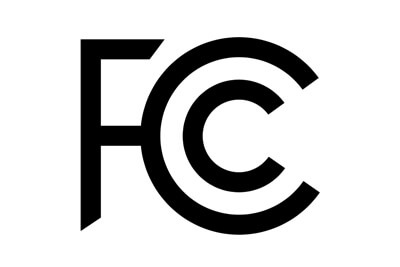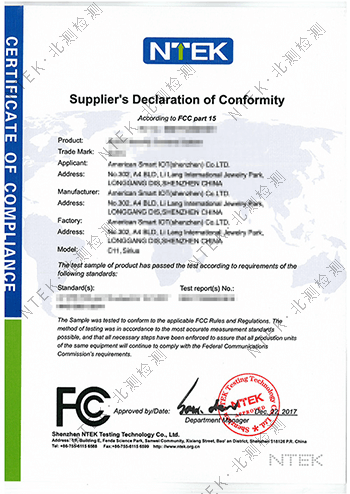Introduction to FCC certification
The full name of the FCC is the Federal Communications Commission, and the Chinese name is the US Federal Communications Commission. Established by COMMUNICATIONACT in 1934, it is an independent agency of the United States Government and is directly accountable to Congress. The FCC coordinates domestic and international communications by controlling radio, television, telecommunications, satellite and cable. Involving more than 50 states in the United States, Columbia, and the United States Territory To ensure the safety of radio and wire communications products related to life and property, the FCC's Engineering and Technology Department is responsible for the technical support of the committee and is also responsible for equipment approval. Many radio applications, communications products and digital products require FCC approval to enter the US market.

Certification type
Type of certification US Federal Communications Commission FCC merged DoC and Verification into SDoC (Supplier's Declaration of Conformity) on November 2, 2017. SDoC certification will replace FCC Verification and DoC certification procedures. All FCC Verification and DoC certification procedures are applicable. The equipment can adopt the SDoC certification procedure.
The FCC is divided into two different certification methods for the types of electronic products: FCC SDoC and FCC ID (Certification). The former is applicable to ordinary products without wireless functions, and the latter is applicable to products with wireless functions.
Applicable product range
1. Power supply: communication power supply, switching power supply, adapter, wireless charging, charger, display power supply, LED power supply, LCD power supply, UPS, etc.
2. Lamps: ceiling light, wall light, pendant light, track light, garden light, portable light, down light, street light, light string, table lamp, floor lamp, grille lamp, aquarium lamp, energy-saving lamp, LED street lamp, LED table lamp, LED floor lamp , LED ceiling light, LED spotlight, LED bulb light, LED tube, LED lamp, energy saving lamp, T8 tube, etc .;
3. Home appliances: refrigerator, washing machine, electric fan, tower fan, leafless fan, air-conditioning fan, mobile air conditioner, humidifier, dehumidifier, clothes dryer, hanging iron, air purifier, fresh air system, vacuum cleaner, cleaner, Mite remover, floor sweeping robot, air conditioner, range hood, dishwasher, electric oven, disinfection cabinet, integrated stove, commercial kitchen equipment, electric water heater, air energy water heater, electric hot water faucet, water purifier, water dispenser, juicer , Juice machine, wall breaker, coffee machine, bread machine, electric oven, air fryer, eggbeater, electric cooker, cooking machine, rice cooker, yogurt machine, noodle machine, electric pressure cooker, soy milk machine, Microwave ovens, induction cookers, electric ceramic stoves, electric cake stalls, electric kettles, hair dryers, beauty instruments, cleansers, curlers, hair straighteners, hair clippers, shavers, oral care, epilators, massage chairs, massagers, Scales, etc.
4. Electronics: TV, audio, power amplifier, DVD, VCD, projector, camera, monitor, computer, server, scanner, printer, copier, headset, mouse, keyboard, router, mobile phone battery, laser pointer, etc .;
5. Communication products: telephones, fax machines, telephone recorders, data machines, data interface cards and other communication products.
6. Wireless products: Bluetooth BT products, tablet computers, wireless keyboards, wireless mice, wireless readers, wireless transceivers, wireless walkie-talkies, wireless microphones, remote controls, wireless network devices, wireless image transmission systems and other low-power wireless products Wait;
7. Wireless communication products: 2G mobile phones, 3G mobile phones, 3.5G mobile phones, 4GS mobile phones, network cards, DECT mobile phones (1.8G, 1.9G frequency), wireless walkie-talkies, etc .;
8. Machinery: gasoline engine, electric welding machine, CNC drilling machine, tool grinder, lawn mower, washing equipment, bulldozer, elevator, puncher, dishwasher, water treatment equipment, gasoline welding machine, printing machine, woodworking machine, rotary machine Drilling rig, lawn mower, snowplow, excavator, printing machine, printer, cutting machine, roller, trowel, brush cutter, hair straightener, food machinery, lawn machine, etc .
FCC common standards
As follows, FCC PART 15 and PART 18 are the most widely used:
FCC Standard Application
FCC PART15 C / E / F Intent Radiation Device Test
FCC PART 18 Industrial, Scientific, and Medical Equipment
FCC PART 22 Public Mobile Communication Services
FCC PART 24 Personal Communication Services
FCC PART 25 Satellite Communication Services
FCC PART 27 Other FCC wireless communication services
FCC PART 68 telecommunications terminal equipment
FCC Part 15 regulates emission equipment that is intentional, unintentional, or transient and does not require a personal license in use. It includes technical specifications, administrative requirements, and other market access conditions. The products are mainly divided into four categories: unintentional launch equipment, intentional launch equipment, personal communication equipment without a license, and basic information equipment in a country without a license.
FCC Part 18 regulates the electromagnetic energy emitted by industrial, scientific, and medical equipment (ISM) operating in a certain frequency spectrum to avoid harmful interference from such equipment to authorized wireless communications services.
Application process
1. The client submits an application form to the testing agency;
2. The customer prepares test samples (fixed frequency machines are required for wireless products) and provides product information (see data requirements);
3. The testing agency issues a draft report, the customer confirms, and issues a formal report;
4. If it is FCC sDoC, the project is completed; if it is FCC ID, submit report and technical information to TCB;
5. The TCB audit is completed and the FCC ID certificate is issued, and the testing agency sends a formal report and FCC ID certificate;
6. After the enterprise obtains FCC certification, it can use the FCC logo and related Statement on its products;
Note: Manufacturers who apply for FCC ID certification for the first time need to register with the FCC-FRN to establish an application company file. The certificate issued after the TCB audit is completed will have an FCC ID number. Usually the FCC ID is "Grantee code" "Product code".
Manufacturer code: It is a three-digit number or capital letter, issued directly by the FCC;
Product code: It consists of numbers, letters, and "-", but two or more consecutive "-" cannot be used, and the first and last digits cannot be used "-". Digits, the number can be customized by the customer.
Certificate information
 Hot Line
400-800-6106
Hot Line
400-800-6106

